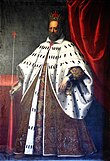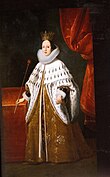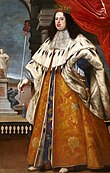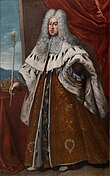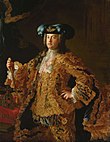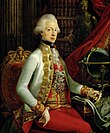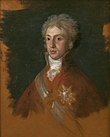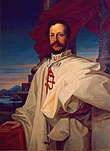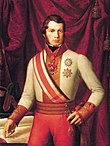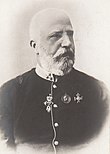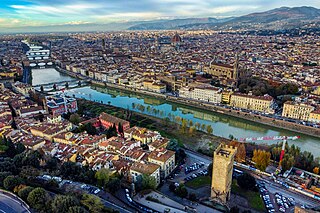
Florence is the capital city of the Italian region of Tuscany. It is also the most populated city in Tuscany, with 360,930 inhabitants in 2023, and 984,991 in its metropolitan area.

The House of Medici was an Italian banking family and political dynasty that first consolidated power in the Republic of Florence under Cosimo de' Medici, during the first half of the 15th century. The family originated in the Mugello region of Tuscany, and prospered gradually until it was able to fund the Medici Bank. This bank was the largest in Europe during the 15th century and facilitated the Medicis' rise to political power in Florence, although they officially remained citizens rather than monarchs until the 16th century.

The Republic of Florence, known officially as the Florentine Republic, was a medieval and early modern state that was centered on the Italian city of Florence in Tuscany, Italy. The republic originated in 1115, when the Florentine people rebelled against the Margraviate of Tuscany upon the death of Matilda of Tuscany, who controlled vast territories that included Florence. The Florentines formed a commune in her successors' place. The republic was ruled by a council known as the Signoria of Florence. The signoria was chosen by the gonfaloniere, who was elected every two months by Florentine guild members.
This article deals with the history of Tuscany.

The Duchy of Parma and Piacenza was an Italian state created in 1545 and located in northern Italy, in the current region of Emilia-Romagna.

The Grand Duchy of Tuscany was an Italian monarchy that existed, with interruptions, from 1569 to 1860, replacing the Republic of Florence. The grand duchy's capital was Florence. In the 19th century the population of the Grand Duchy was about 1,815,000 inhabitants.
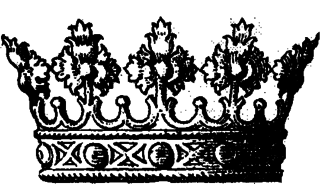
The Duca della Repubblica Fiorentina, rendered in English as Duke of the Florentine Republic or Duke of the Republic of Florence, was a title created in 1532 by Pope Clement VII for the Medici family, which ruled the Republic of Florence. There were effectively only two dukes of the Republic of Florence, Alessandro de' Medici and Cosimo de' Medici, the second duke being elevated to Grand Duke of Tuscany, causing the Florentine title to become subordinate to the greater Tuscan title.

Central Italy is one of the five official statistical regions of Italy used by the National Institute of Statistics (ISTAT), a first-level NUTS region, and a European Parliament constituency.

Virginia de' Medici was an Italian princess, a member of the House of Medici and by marriage Duchess of Modena and Reggio.

Leopoldo de' Medici was an Italian cardinal, scholar, patron of the arts and Governor of Siena. He was the brother of Ferdinando II de' Medici, Grand Duke of Tuscany.

The Duchy of Florence was an Italian principality that was centred on the city of Florence, in Tuscany, Italy. The duchy was founded after Pope Clement VII, himself a Medici, appointed his relative Alessandro de' Medici as Duke of the Florentine Republic, thereby transforming the Republic of Florence into a hereditary monarchy.

Isabella Romola de' Medici was a Tuscan noblewoman and the daughter of Cosimo I de' Medici, first Grand Duke of Tuscany, and Eleonora di Toledo. Beautiful, intelligent, witty and refined, she is often referred to as the Star of the House of Medici, in recognition of "her playfulness, vibrancy, often sarcastic sense of humour, sharpness and interest in a huge variety of topics - not to mention the great parties she held". She received a humanist education alongside her brother, Francesco de' Medici, who succeeded their father as the Grand Duke of Tuscany. To secure Tuscany's southern borders via a relationship with the powerful Roman Orsini family, Isabella's father arranged her marriage to Paolo Giordano I Orsini when she was 16. At her father's behest, she remained in Florence after her marriage, affording her an unprecedented level of independence for a woman of her era.

Lucrezia de' Medici was a member of the House of Medici and by marriage Duchess consort of Ferrara, Modena and Reggio from 1558 to 1561.
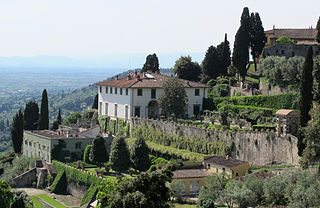
The Medici villas are a series of rural building complexes in Tuscany which were owned by members of the Medici family between the 15th century and the 17th century. The villas served several functions: they were the country palaces of the Medici, scattered over the territory that they ruled, demonstrating their power and wealth. They were also recreational resorts for the leisure and pleasure of their owners; and, more prosaically, they were the centre of agricultural activities on the surrounding estates. In 2013, the Medici villas were added to UNESCO's World Heritage list.
The Grand Ducal Crown of Tuscany was a ducal crown created by the Medicean Grand Dukes of Tuscany.

The flag of Tuscany is the official flag of the region of Tuscany, Italy. The flag depicts a silver Pegasus rampant on a white field between two horizontal red bands. The flag first appeared as a gonfalon on 20 May 1975 along with accompanying text Regione Toscana above the Pegasus. It was officially adopted as the flag of Tuscany on 3 February 1995.

Neoclassical architecture in Tuscany established itself between the second half of the eighteenth century and the first half of the nineteenth century within a historical-political framework substantially aligned with the one that affected the rest of the Italian peninsula, while nonetheless developing original features.
Jacopo Riguccio Galluzzi ) was an Italian writer and historian, mainly of the Medici dynasty and era in Florence.


